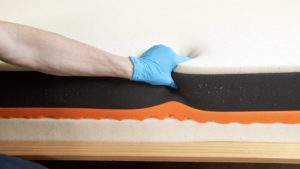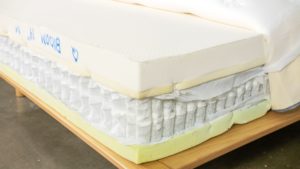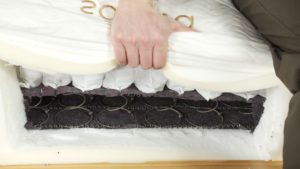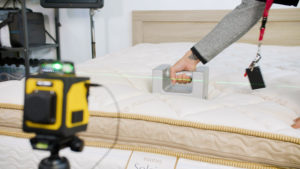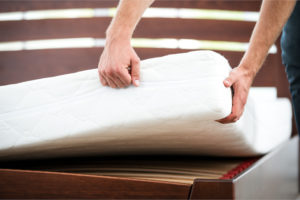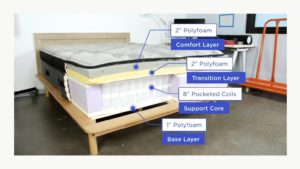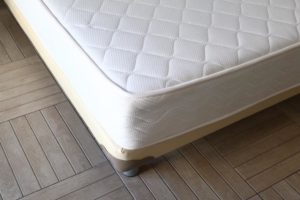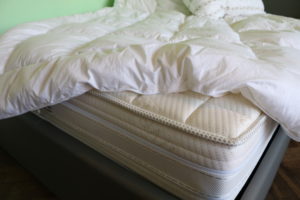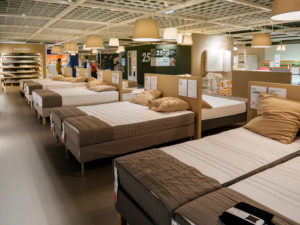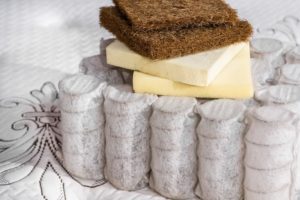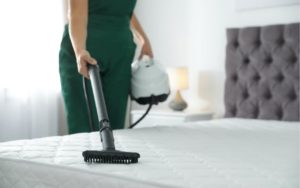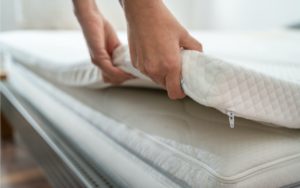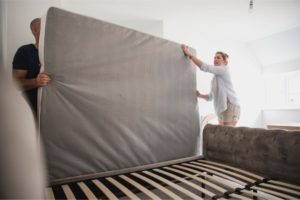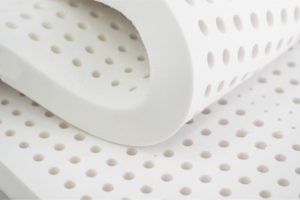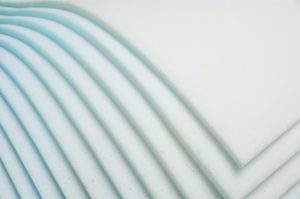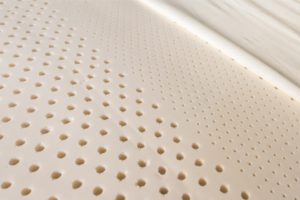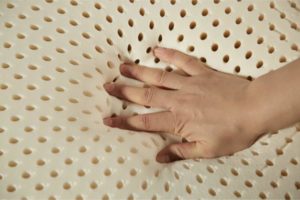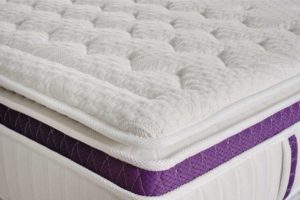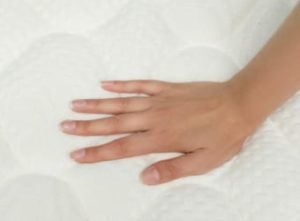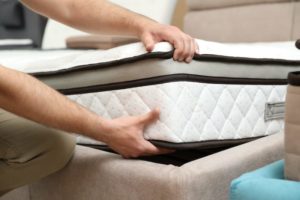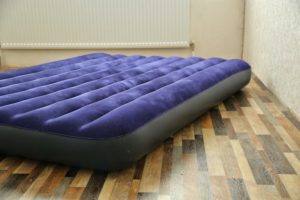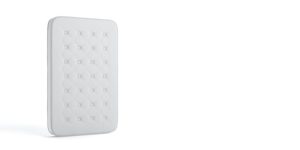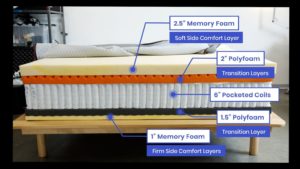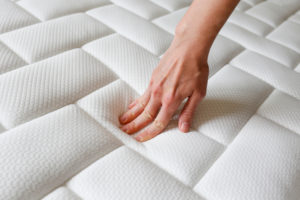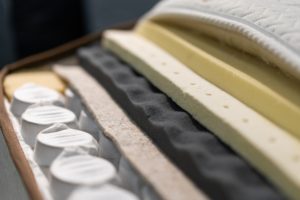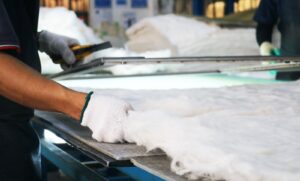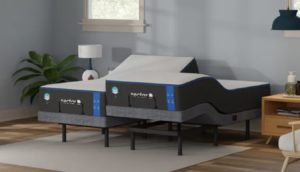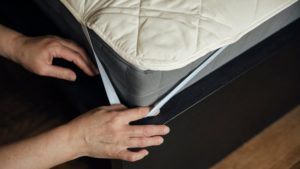When you buy through our links, we may earn a commission. Products or services may be offered by an affiliated entity. Learn more.
What Is Memory Foam?
If you’ve been in the market for mattresses lately, you’ve probably heard the term “memory foam.” Mattresses come in many different styles, using many different materials, and memory foam has become one of the most popular.
First designed in the 1960’s for use in NASA spaceship seats and seatbelts, shock-absorbing, pressure-relieving memory foam has also been used as cushioning in helmets and shoes, and use in prosthetics and wheelchair seating pads. However, it wasn’t until the 1990’s, when Fagerdella World Foams released their flagship TempurPedic Swedish mattress, that memory foam was introduced as a mattress material. Since then, memory foam mattresses have exploded onto the market, especially with the growth of mattress-in-a-box brands.
But what exactly is memory foam? What is it made of, how does it work, and how do you know if it’s the right choice for you?
We’ve got you covered. In this guide to all things memory foam, we’ll break down the ins and outs of the material, how it’s used in mattresses, and what to look for as a smart mattress shopper.
Check out our full guide with research if you’re looking to find the best memory foam mattresses?
Let us help you find the perfect bed
Answer a few questions to find the right mattress for your unique needs
What Is Memory Foam Made Of?
First thing’s first: what is memory foam, physically?
The main component of memory foam is a polymer (a substance with large molecules, consisting of many small, similar subunits bonded together) called polyurethane. Polyurethane is an incredibly common and versatile plastic polymer that can be used to produce a wide range of materials and products, including furniture like sofas and mattresses, but also products like insulation, liquid paints and primers, spray foam, elastic fibers, car parts, and even tough elastomers like roller blade wheels.
Memory foam is what is known as “viscoelastic” polyurethane foam, or low-resistance polyurethane foam (LRPu). It is created by adding various compounds and additives to polyurethane, which change depending on the type of foam being created.
Ultimately, these chemicals affect two of the main qualities of memory foam: viscosity and elasticity. In the context of memory foam, when we say that the material is “viscous”, we mean that it takes a long time to change shape under pressure, or to transfer energy from one place to another. When we say a material is “elastic”, it means it can stretch or contort but return to its original shape or size when the stretching force is taken away,
Different manufacturers have different “recipes” for the chemicals they add to the foam and the processes they use to create the foam. These recipes and processes affect the feel and function of each individual memory foam product, and are often proprietary secrets. However, as a general rule, the viscoelastic foam used in most memory foam mattresses contains at least some degree of a compound called polyether polyol, which helps give the foam both elasticity and viscosity.
How Does Memory Foam Work?
As we outlined above, memory foam mattresses are designed to slowly mold to the body in response to pressure, and therefore to evenly distribute body weight. They are also designed to be resilient, and to return to their original shape once body weight and pressure is removed.
Memory foam softens when it comes into contact with your body heat, molds to your unique contours, and distributes your weight equally. The material responds differently depending on how you apply pressure, or “force”. If you apply pressure quickly, the foam tends to change shape more slowly, or “reluctantly.” This means that memory foam is excellent at absorbing the force of an impact, which is why it was originally used in areas like space shuttle construction. When memory foam is used as a mattress material, this quality helps the mattress cushion the body evenly, and creates the slow contouring feeling as the mattress adapts to the impact of your body and re-forms around your curves.
Memory foam also returns relatively slowly to its original shape when force is removed–on average, around 5-10 seconds. During this recovery period, energy from the impact is absorbed and dissipated. This time lag, a phenomenon known as “hysteresis”, also helps cushion sleepers, because it removes some of the pressure (or, impact energy) produced by the prone body.
Another important part of how memory foam works is that its viscosity decreases with temperature. This means that it becomes less stiff and more flexible the hotter it gets. This is the reason why memory foam mattresses feel softer or more pliable after you’ve been lying on them for a time, since your body heat increases the temperature of the sleep surface.
Different Types of Memory Foam Mattresses
Memory foam mattresses come in a wide variety of sizes, shapes, and construction-styles. Beyond the proprietary differences in compounds and processes when it comes to each individual foam product, there are several basic types of memory foam.
Types of Memory Foam
By and large, there are three main types of memory foam:
Traditional
This is the original, “classic” memory foam. It was the first memory foam to enter the market for consumer use. Traditional memory foam is engineered to mold to your body and is constructed the way we have outlined above. One issue with traditional memory foam is that it has a tendency to retain heat, which can cause the sleeping surface of mattresses using that foam to become uncomfortably warm. The two other types of memory foam were created in part to address that issue.
Open-Cell
Open-cell memory foam has the same ingredients as traditional memory foam, but with a different internal structure. Open-cell memory foam mattresses have internal pockets (or, “open cells”) that allow for ventilation and air flow throughout the mattress, which helps disperse heat.
Originally, open-cell memory foam mattresses were far less dense, which sometimes affected the firmness of the mattress and made them feel less supportive. However, new production technologies have been developed to address that issue while also retaining the open-celled structure of the mattress (and therefore retaining the cooling effect).
Gel
Another type of memory foam incorporates gel in its construction. Gels are usually added to the mattress by pumping gel-based microbeads into the foam. These microbeads create pockets similar to those that exist in open-cell mattresses. Rather than simply letting air through the mattress, these gels are generally “phase-changing” materials, meaning they actively absorb and release heat from your body.
Some mattresses use foams that only fit one of these categories, but many modern memory foam mattresses incorporate several, if not all three.
In addition to these three basic types, some memory foam mattress developers now add other materials to their mattresses, often specifically for the purpose of cooling. One of those materials is copper. Copper is highly conductive, and helps with both heat-dispersal and moisture-wicking when used in memory foam mattresses. There are mattresses that fit the description of all three of the main types of memory foam that incorporate copper in their construction.
Another up-and-coming innovation in memory foam is the development of more eco-friendly foams. These eco-friendly memory foams (or, “greener memory foams”) incorporate more plant-based materials than the average memory foam mattress. For instance, they may replace some of the petroleum-based compounds and derivatives used in standard memory foam manufacturing with compounds and derivatives made from soy or corn oil. These manufacturing techniques are still relatively new, but they are becoming more common as the technology develops.
Mattress Construction
Memory foam is used in mattresses in several different ways. For one thing, different memory foam mattresses have different constructions designed to achieve specific qualities. However, there is a basic template that most memory foam mattresses follow, even if the unique components differ. That template has three components:
- Comfort Layer: This top section of the mattress is composed of one or more foam layers that are generally designed to provide contouring and cushioning, depending on the level of firmness of the mattress. Many mattress designs use more breathable foams in this section, in order to keep heat away from the sleeping surface.
- Transition Layer: This section of the mattress is composed of one or more foam layers meant to work between the comfort layers and the core. They tend to be slightly firmer than the foam in the comfort levels, and often help wick heat away from the comfort layer.
- Core: This is the base of the mattress. It is often composed of much firmer foam, and is the largest layer, usually by far. It provides stability and support to the mattress through the other foam layers. In some mattresses, called hybrid mattresses, the core is not foam, but rather is the same sort of core you would find on an innerspring mattress. This tends to provide additional support, bounce, and ventilation.
Qualities of Memory Foam
Now that we know what memory foam actually is, we can move on to how it feels, and what sleeping on a memory foam mattress is like. In general, there are three main characteristics describe memory foam mattresses as a whole, though different mattresses will offer varying levels of each of these qualities
- Contouring: One of the hallmark characteristics of memory foam is right there in the name. When you lie down on a memory foam mattress, you can feel the sleep surface contour specifically to the curves and angles of your body.
- Sink: In addition to contouring, memory foam tends to have a “sink” to it–that is, the feeling of being embraced by the mattress, and even of sinking down into it.
- Palpable Response: As mentioned above, memory foam is extremely adaptive to pressure, and you can feel the material becoming more pliable and less viscous in response to the pressure and heat of your body when you lie down.
Memory Foam Pros and Cons
In addition to the unique feel of the foam, memory foam mattresses have many other specific qualities–some of which make people love them, and some of which can turn people off. Many people love the foam’s adaptive feel of memory foam, but it isn’t for everyone and some find memory foam downright uncomfortable. Disadvantages of a memory foam mattress can include excessive softness, poor temperature regulation, and strong initial off-gassing odor.
When talking about memory foam, it is therefore important to address both commonly reported benefits and commonly reported complaints.
Memory Foam Pros
Provides Pressure Relief: Memory foam contours to the body, using your own body heat and pressure to conform to your shape. This can provide relief in areas of the body we put the most pressure on during sleep, such as the hips, shoulders, and neck. Putting regular, disproportionate pressure on those parts of the body can cause pain upon waking, as well as trouble getting to sleep and staying asleep.
For some people, especially those with joint pain or arthritis, memory foam’s contouring qualities can reduce pain and discomfort by evenly distributing weight and taking the stress off of common pressure points.
Promotes Spinal Alignment: Another plus of memory foam’s contouring qualities is that for many sleepers, it promotes good spinal alignment and provides lumbar support. When a surface responds to the natural curves of the body like memory foam does, it can be easier to find sleeping positions that keep your spine in neutral alignment. This can prevent tossing and turning at night, as well as back pain and soreness in the morning.
Allergen Resistant: One major benefit of memory foam mattresses is that they tend to resist the buildup of common allergens for people with allergies. Because of their dense structure, memory foam mattresses are less likely to attract and accumulate allergens, such as dust mites, mold, and other common irritants.
Reduces Motion Transfer: For co-sleepers and couples–especially those who are light sleepers–making sure you can’t feel it if your partner moves or gets up at night is very important when considering a mattress.
If preventing motion transfer is a priority for you, memory foam has a significant advantage. Because of the density of memory foam and the way it responds to and distributes pressure, it does a good job of keeping motion on one part of the bed from being felt on another part of the bed.
Quiet: Memory foam mattresses are also notable for being quiet. This is important for couples who don’t want to wake their significant others when getting out of bed, but also for anyone who doesn’t want to be bothered with the squeaking, groaning, or various other noises that can come from a particularly noisy bed.
Memory Foam Cons
Heat Retention: One of the main complaints about memory foam mattresses is that they tend to trap heat and become uncomfortably warm. Because they are designed to respond to body heat, and because of the density of the material, memory foam can, in fact, get quite warm, especially traditional memory foam.
Though there have been innovations in memory foam technology to address this issue (such as open cell and gel foams, and other cooling construction methods), they still generally retain heat more than other types of mattress. This can cause trouble getting to sleep and staying asleep, especially if you’re already a hot sleeper.
Cost: Another issue with memory foam is the fact that they tend to be pricier than other mattresses. This is especially true if you get a particularly high-quality memory foam mattress: compared, for instance, to a similar-quality innerspring mattress, memory foam mattresses will usually have a higher price tag.
As memory foam mattresses become more widespread, and especially as mattress-in-a-box companies are becoming more popular, the general cost of memory foam mattresses has gone down. However, it is still, by in large, the costlier option.
Not Waterproof: Memory foam mattresses (as well as memory foam toppers and pillows) can be damaged by water, and by moisture/liquid in general. Liquids can degrade the foam, and reduce the lifespan of a memory foam mattress. This is particularly inconvenient if you live in a high-humidity area, or if you have a young child or pet that is prone to spills or accidents. It also makes cleaning a memory foam mattress particularly difficult.
“Stuck” Feeling: Some people find that the memory foam feel can leave them feeling too sunk down into the mattress, such that they feel stuck or sucked up into the material. This can make it more difficult to move during the night, and some people just generally find it uncomfortable or off-putting. The sinkage of a memory foam mattress tends to increase as the mattress ages, so people who are particularly turned off by that feeling will only dislike it more with time.
Off-Gassing and Odors: When they are first produced, memory foam mattresses tend to have a distinct, chemical-like smell. This is referred to as “off-gassing.” Generally, the smell goes away within around 24 hours after unboxing, but sometimes it can stick around for weeks. Memory foam mattresses using cheaper materials have stronger and longer-lasting off-gassing.
Heavy/Difficult to Move: These days, many memory foam mattresses come as a mattress in a box, which gives off the illusion that they’re lightweight. However, this is not generally the case. Once a memory foam mattress is set up, it is, on average, quite a bit heavier than other types of mattresses.
This can cause issues when trying to lift the mattress to change the sheets, or when trying to reposition the mattress. It can also be a major pain when moving, especially when it comes to a mattress in a box, as it is likely going to be much harder to get the mattress out of the room than it was to bring it in.
How to Pick the Right Memory Foam Mattress
If you’ve decided that memory foam sounds like the right choice for you, there’s still a good deal you should know when looking for your best mattress match. Here are some general pointers about what to look for in a memory foam mattress
Firmness
Mattresses come with many different levels of firmness. Mattress firmness is generally described on a scale between very soft and very firm, often broken down numerically between 1 (very soft) and 10 (very firm). Think of it as a more nuanced Goldilocks and the Three Bears scenario: some people like their mattresses very firm, some like them very soft, and some like them somewhere in the middle.
Most mattresses will be described in-store or online as landing somewhere on the soft-firm scale. However, if that info isn’t there or if it isn’t detailed enough, you can look for an Indentation Load Deflection (ILD) rating. This is basically a measure of firmness: the higher the ILD rating, the firmer you can expect the mattress to be. According to the way ILDs are scored, each layer of the mattress (ie, comfort, transition, support, etc.) has its own ILD score, and then the mattress as a whole has an overall ILD score. On the ILD scale, a mattress with an overall ILD of 10 would be very soft, while a mattress with an ILD of 50 would be very firm. If you want something in the middle, judge by those standards.
Density
The density of memory foam is the measure of how much actual foam is built into each layer of the mattress. Memory foam comes in a variety of different densities, which are measured in pounds per cubic foot (PCF). In general, the higher the density of the foam, the longer it will keep its shape, elasticity, and support structures. However, higher density foams also tend to sleep hotter.
If you’re an average-temperature sleeper (ie, you don’t sleep particularly hot), a good density that cuts the difference between longevity and heat retention is around 3.0-5.0 PFC.
Thickness
When it comes to memory foam mattresses, thickness refers to how many inches the mattress measures from the side. This is different from density: for instance, three inches of foam could have an ILD score of 10 or 50. Memory foam mattresses range in thickness from around 6 inches to around 14 inches. As a rule, thicker mattresses are more supportive than thinner mattresses, and can also be softer, depending on the mattress.
In addition to the thickness of the mattress as a whole, you should also consider the thickness of each individual level. Memory foam mattresses work best if there are at least four inches of combined comfort and transition foam between the sleep surface and the mattress base. This helps ensure that you will get the benefits of the support core without the mattress becoming uncomfortable.
Standardized Testing Certifications
Lower quality memory foam mattresses can have additives that can degrade the material, lower the lifespan of the mattress, and even possibly cause irritation and/or give off fumes that are questionable health-wise. When choosing your mattress, you should look out for a Certipur-US certification. This is a seal of approval that ensures that the memory foam in the mattress is made without certain chemicals that can be harmful to the mattress and possibly to your health.
A mattress with Certipur-US certification is not made with any mercury, lead, heavy metals, or formaldehyde. They are also made without phthalates (plasticizers that may be harmful to reproductive health) and PBDEs (Polybrominated diphenyl ethers, a flame retardant that is banned in the US for negative health effects, but which is sometimes used in mattress manufacturing abroad). These certified mattresses also have a lower concentration of volatile organic compounds (VOCs), which are the main cause of the chemical smell that comes from off-gassing.
Choosing a mattress with certified foam gives you one less thing to worry about when it comes to the quality, lifespan, and safety of your mattress, so it’s worth it to check if a mattress is certified before committing.

Still have questions? Ask our community!
Join our Sleep Care Community — a trusted hub of sleep health professionals, product specialists, and people just like you. Whether you need expert sleep advice for your insomnia or you’re searching for the perfect mattress, we’ve got you covered. Get personalized guidance from the experts who know sleep best.

